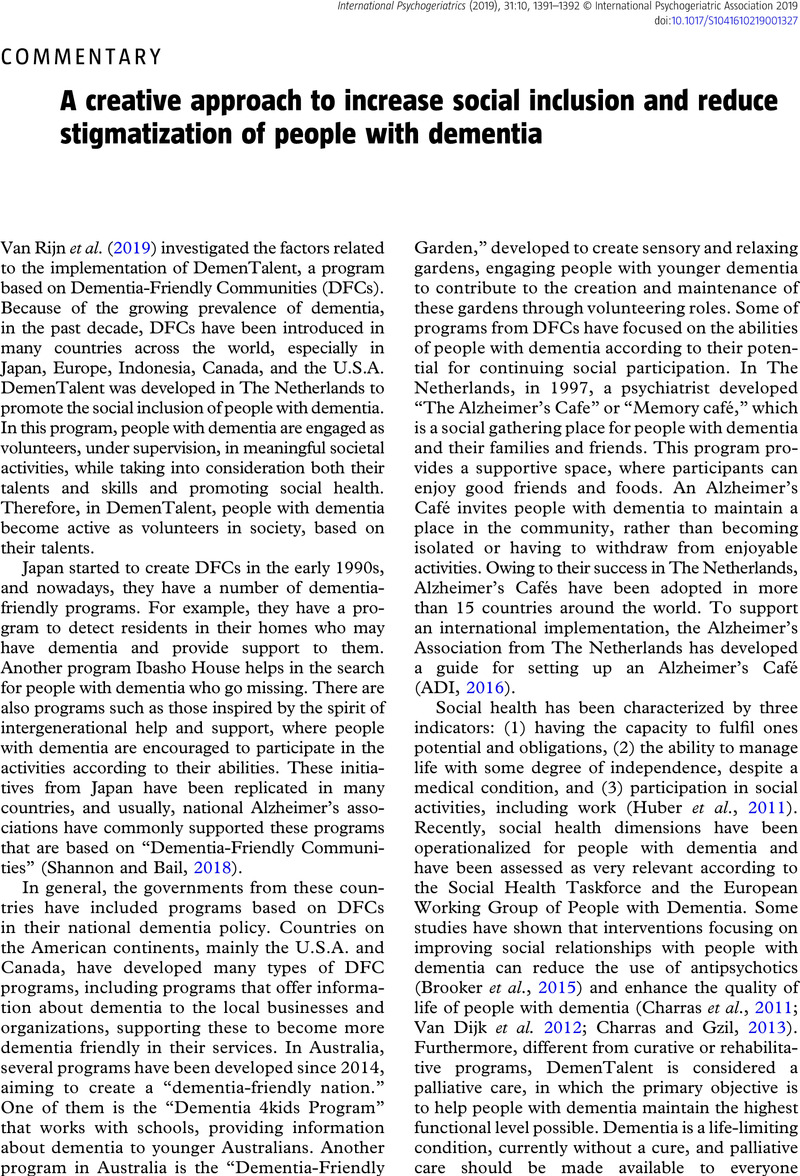No CrossRef data available.
Article contents
A creative approach to increase social inclusion and reduce stigmatization of people with dementia
Published online by Cambridge University Press: 28 October 2019
Abstract
An abstract is not available for this content so a preview has been provided. Please use the Get access link above for information on how to access this content.

- Type
- Commentary
- Information
- International Psychogeriatrics , Volume 31 , Issue 10: Issue Theme: Dementia and the Society , October 2019 , pp. 1391 - 1392
- Copyright
- © International Psychogeriatric Association 2019
References
Alzheimer’s Disease International (2016). Dementia Friendly Communities: Key principles [Internet]. London: Alzheimer’s Disease International. Available from: https://www.alz.co.uk/adi/pdf/dfc-principles.pdf.Google Scholar
Brooker, D.J. et al. (2015). FITS into practice: Translating research into practice in reducing the use of anti-psychotic medication for people with dementia living in care homes. Aging & Mental Health, 20, 1–10.Google ScholarPubMed
Charras, K., Eynard, C., Viatour, G. and Fremontier, M. (2011). The Eval’zheimer® model: Fitting care practices and environmental design to institutionalized people with dementia. Neurodegenerative Disease Management, 1, 29–35.10.2217/nmt.10.2CrossRefGoogle Scholar
Charras, K. and Gzil, F. (2013). Judging a book by its cover: Uniforms and quality of life in special care units for people with dementia. American Journal of Alzheimer’s Disease and Other Dementias, 28, 450–458. doi: 10.1177/1533317513488915.CrossRefGoogle ScholarPubMed
Huber, M. et al. (2011). How should we define health? BMJ, 343, d4163.10.1136/bmj.d4163CrossRefGoogle ScholarPubMed
Kydd, A. and Sharp, B. (February 2016). Palliative care and dementia—A time and place? Maturitas, 84, 5–10.10.1016/j.maturitas.2015.10.007CrossRefGoogle ScholarPubMed
Shannon, K. and Bail, K. (2018). Dementia-friendly community initiatives: An integrative review. Journal of Clinical Nursing, 28, 2035–2045. doi: 10.1111/jocn.14746.CrossRefGoogle Scholar
van Dijk, A.M., van Weert, J.C. and Droes, R.M. (2012). Does theatre improve the quality of life of people with dementia? International Psychogeriatrics, 24, 367–381. doi: 10.1017/S1041610211001992.CrossRefGoogle ScholarPubMed
van Rijn, A., Meiland, F. and Dröes, R.M. (2019). Linking DemenTalent to Meeting Centers for people with dementia and their caregivers; A process analysis into facilitators and barriers in 12 Dutch Meeting centers. International Psychogeriatrics, 31, 1433–1445.10.1017/S1041610219001108CrossRefGoogle ScholarPubMed




